Sound Giants: Pentagon Programmer and Great Stalactite Organ
Our cycle of the largest sound structures would not be complete without gigantic musical instruments. Now we will talk about the "Great Stalactite Organ". According to the Guinness Book of Records, the tool that we describe is considered the largest ever created. This post is about how programmer and mathematician Leland Sprinkle made Virginia's Luray Caverns sing stalactites.
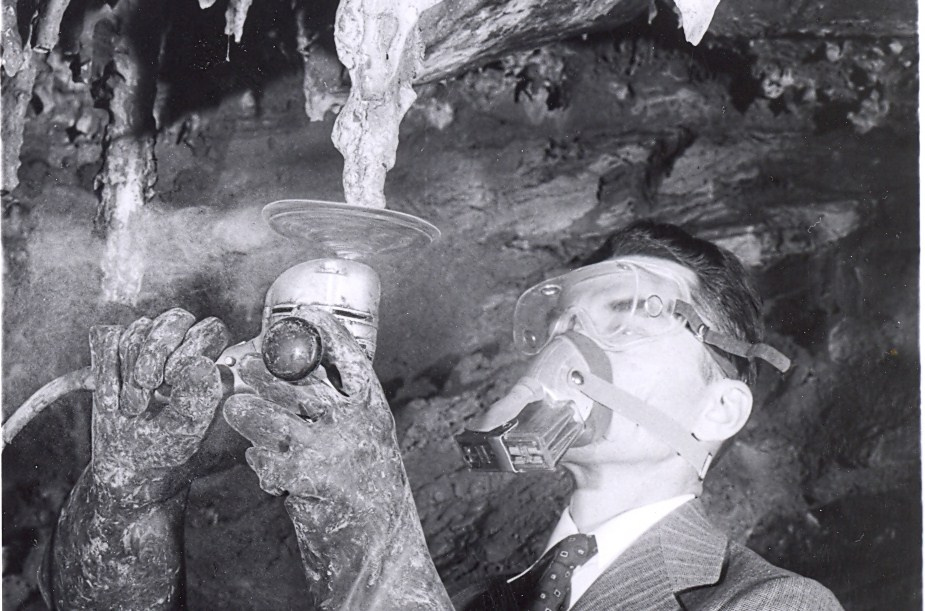
To some extent, this material can be attributed to our other cycle “Personality and Sound”, since it will be devoted not only to the instrument, but also to its creator.
Lureysky caves, located in Virginia (USA), were discovered by American speleologists in 1878. A group of scientists from Smithsonian University, led by Andrew Campbell, who studied the caves in the late 19th century, almost immediately drew attention to the interesting musical possibilities of rocky growths. The ability of stalactites to make interesting musical sounds on impact was noted in the Campbell report in 1880. According to the memoirs of the expedition participants, speleologists even managed to play several melodies.
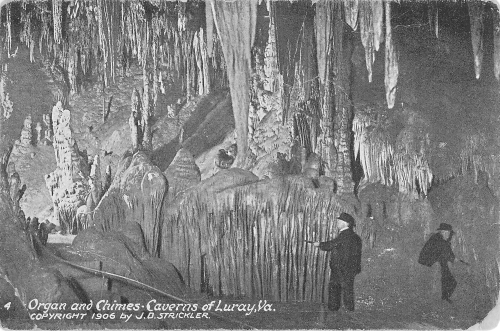
At the beginning of the last century, the cave becomes a frequently visited sightseeing object. At this particular time, the regular excursion program includes the performance of popular melodies on the stalactites, the US anthem, marches of the times of the civil war and country music. By the mid-30s, cave excursions are losing popularity, which leads to the cessation of large-scale musical performances until 1957. The only thing that the guides did during this period was that they could play several short simple melodies.
Leland Wilfred Sprinkle was a versatile and interesting person. From his youth he was interested in the natural sciences, especially physics. Perhaps the world would recognize him not as the inventor of a unique musical instrument, but as one of the luminaries of physical science, but the tragic circumstances made adjustments to his fate.
In the late 1930s, as a young scientist, Leland began to prepare his doctoral dissertation in physics at Harvard, but could not complete and defend it. His father suddenly fell ill with appendicitis and, as a result of postoperative complications, died. Caring for his mother fell on Leland's shoulders and slowed down his scientific career.
Immediately after Harvard, he works in the US Treasury and the Federal Housing Administration. In the 1940s, Leland joined the US Department of Defense and began active work at the Pentagon as a computer programmer, mathematician, theorist, and electronics engineer. Many of his works were closely related to sea-based aviation and bomber aircraft, for example, pre-flight calculation algorithms. It is also known that he is one of the leading developers who worked on the creation of the UNIVAC computer.
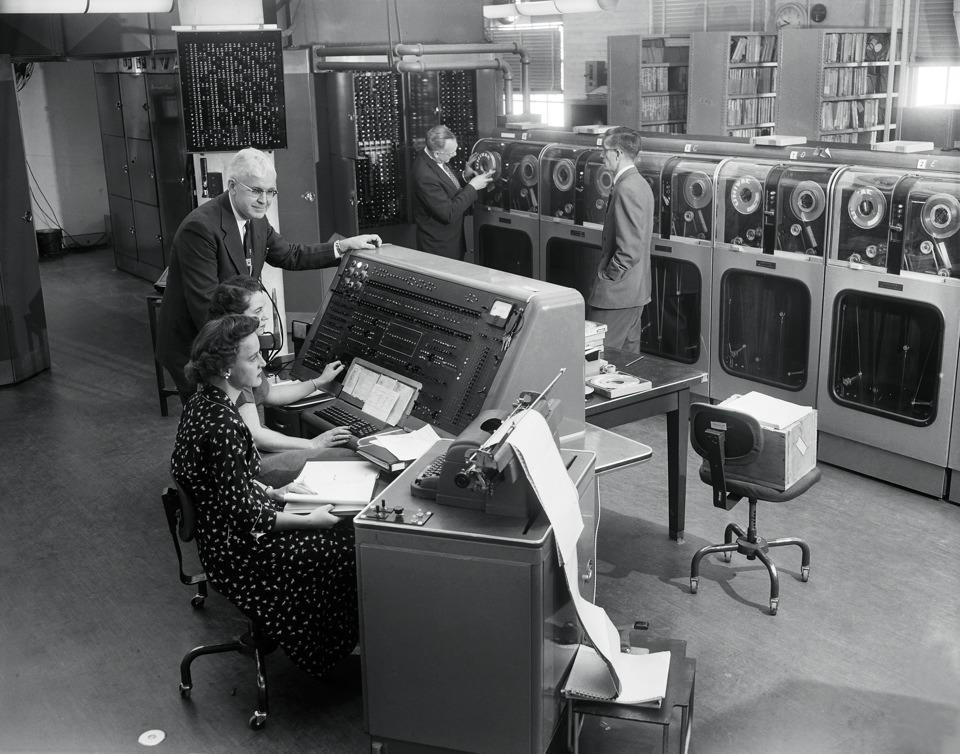
UNIVAC
At the same time, the secret scientist was seriously interested in music, especially organ music, and from 1945 he studied to play this instrument at the Peabody Conservatory. The scientist did not leave a musical hobby and even received several patents for inventions in the musical field related to the rationalization of the organ systems that existed at that time.
I believe that the best description of Sprinkle as a scientist and inventor, was given in an interview by one of his sons - Dr. Robert Sprinkl:
In addition, the son noted that the work of Leland was titanic and useful, but unobtrusive for his leadership, rarely received due recognition at the Pentagon. But this little worried scientist, who at times was more passionate about invention and music, rather than routine military developments.
In other words, Leland Sprinkle was a modest rationalizer by a perfectionist who earned money as a programmer, a mathematician and an engineer at the Pentagon, but remained a passionate innovator, amateur radio and musician.
The key moment in the creation of the “Great Organ” was the 5th birthday of Leland’s son, Robert, in 1954. To some extent, a five-year-old boy (in the future PhD) contributed to this matter. Leland offered his son a choice: celebrate his birthday at home or go on an excursion to the caves, and Robert chose the latter. During a visit to the cave, guides at a location called the Throne Room performed one of the folk tunes, tapping on stalactites like a xylophone. At that moment, the idea of a “Great organ” was born in the programmer’s head “the light was on fire ”.
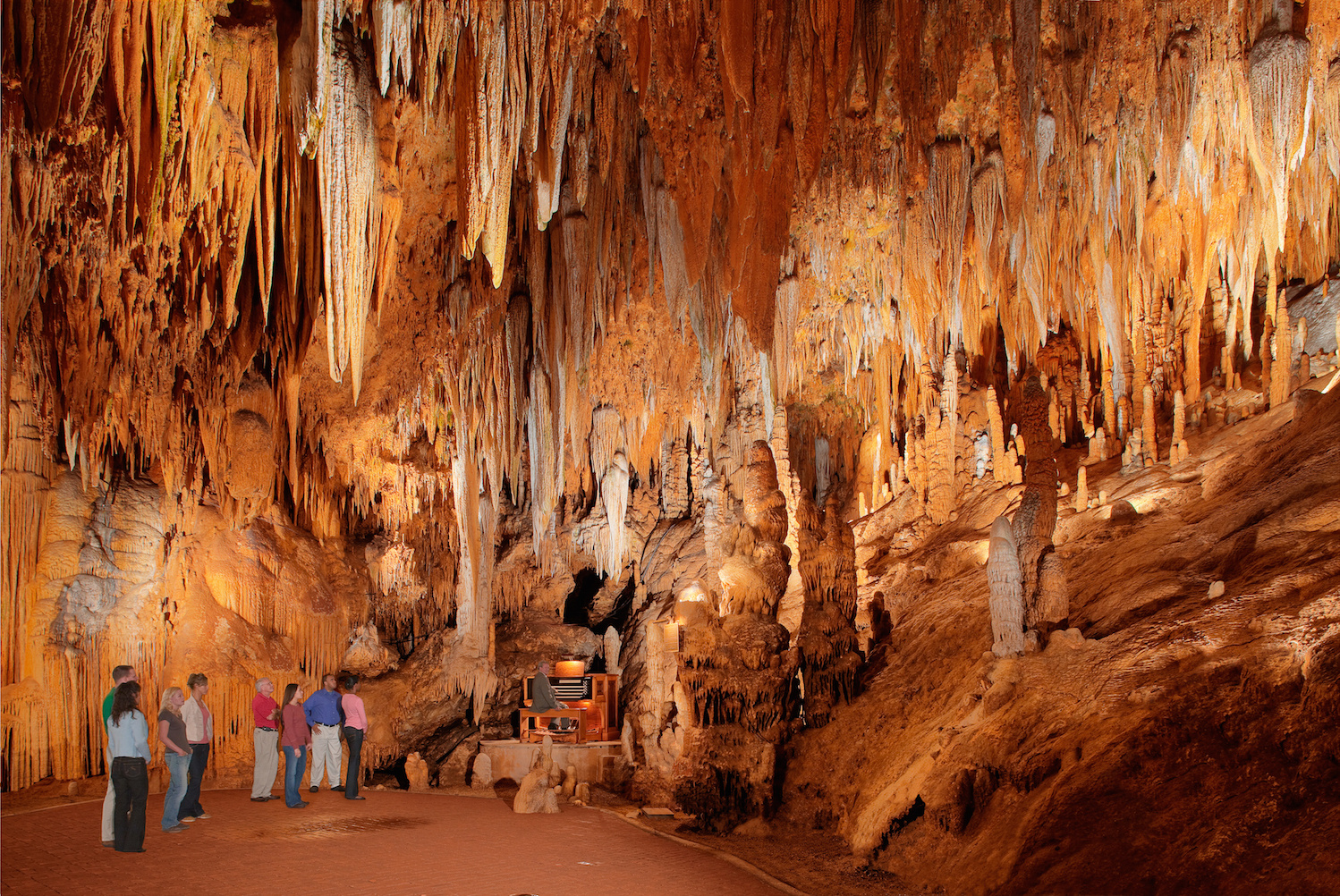
Modern day trip to Luray Caverns
Played the role and the fact that the cave Lurey and then and now are private property, which reduced the number of bureaucratic delays. Leland Sprinkles met with cave master Ted Graves. Sprinkle considered unlikely a situation in which Graves would agree to the creation of an organ, and was surprised that Ted did not even have to persuade. Instead of asking too many questions and a hard refusal, he responded to Leland's adventurous proposal with one phrase: “Of course, why not?”.
The principle that Leland implemented for the tool was simple. The keyboard of the organ was connected with an electromechanical shock mechanism. Depending on the key pressed, the hammer hit the stalactite, and he made a sound with a corresponding note.
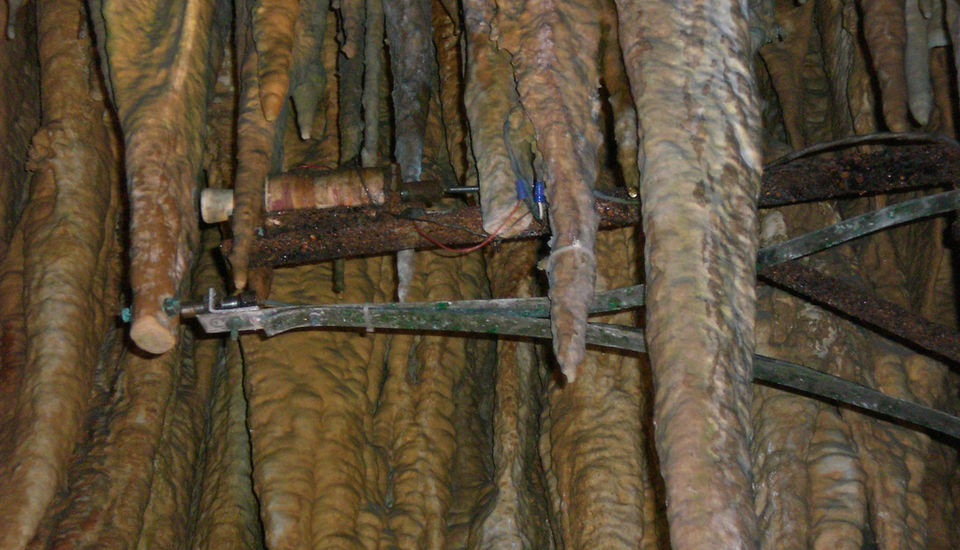
In fact, it is an acoustic percussion instrument of unprecedented size. The reverberation and natural acoustic conditions of the cave created a unique sound, resembling something between a marimba, organ and metallophone.
Only two stalactites made a sound with a clean note, the rest had to be “tuned”. So Sprinkl filed stalactites to the desired size, comparing their sound with a tuning fork.
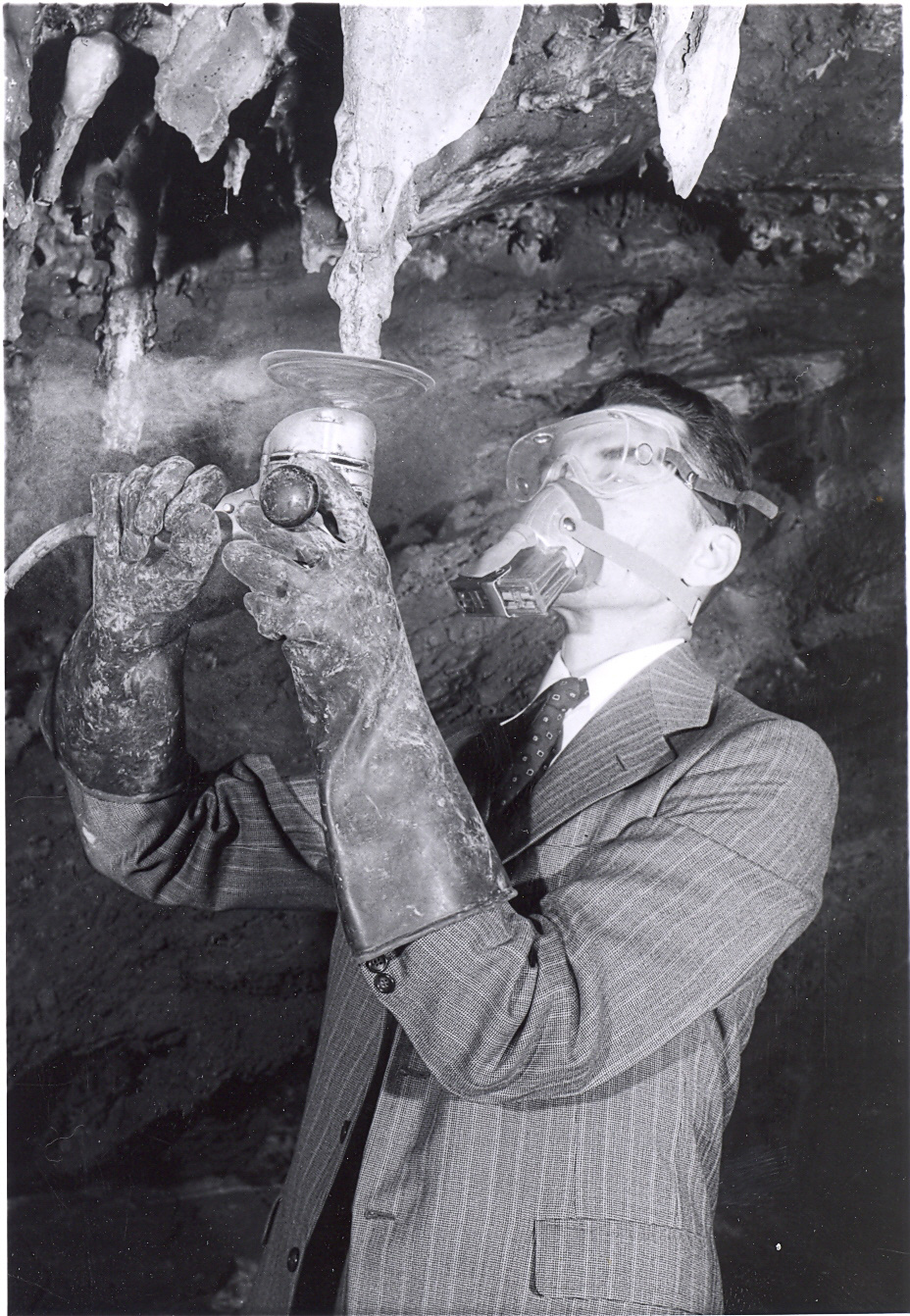
Leland Strinkle "adjusts" stalactite 1956
A big problem was the conditions in the cave, the temperature over 40C and the high level of humidity, which had a detrimental effect on the electrical circuits and mechanical parts of the organ.

Work on overcoming the problems, finding and preparing the necessary stalactites, placing the tool systems lasted 3 years. Due to the lack of experience in creating an organ keyboard, Sprinkle turned to Klann Organ Supply, which produced a unique console that still works today.
The console of the body is represented by four five-octave keyboards (different keyboards provide a different character of sound), allowing to extract only 36 whole tones and 25 semitones from the rock, just such a number of stalactites were able to produce the necessary sounds.
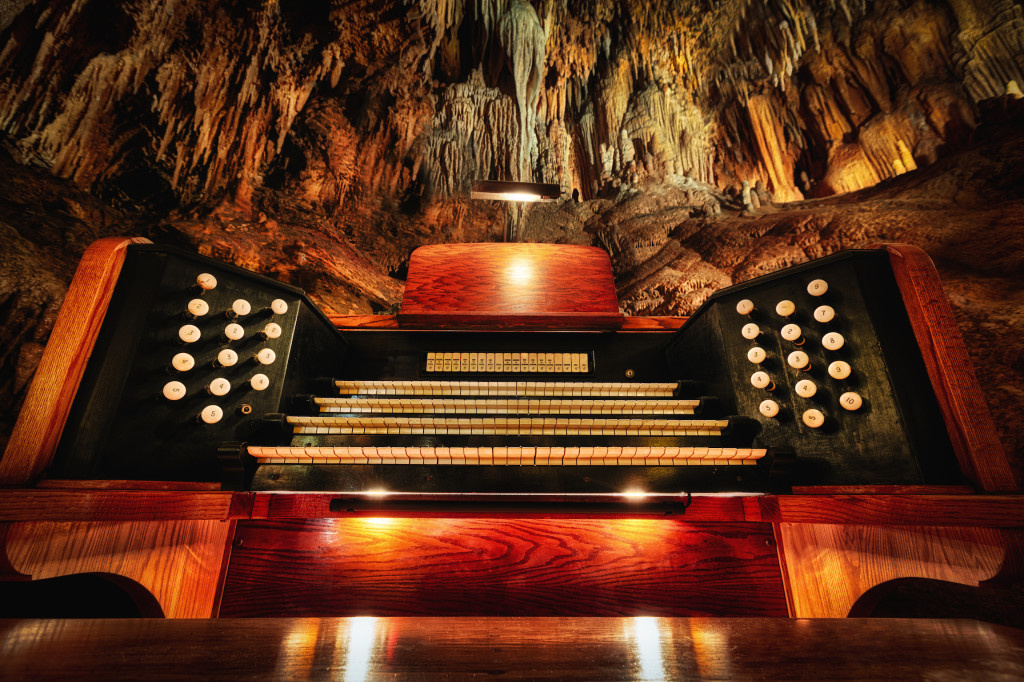
It is believed that in the next 5 hundred years no additional tincture will be needed. The stalactites used as sound sources are located on an area of 14,000 square meters. Due to the peculiarities of cave acoustics, the sound they emit is heard over an area of 260,000 square meters. To switch all the sounding stalactites needed cables with a total length of 5000 meters.
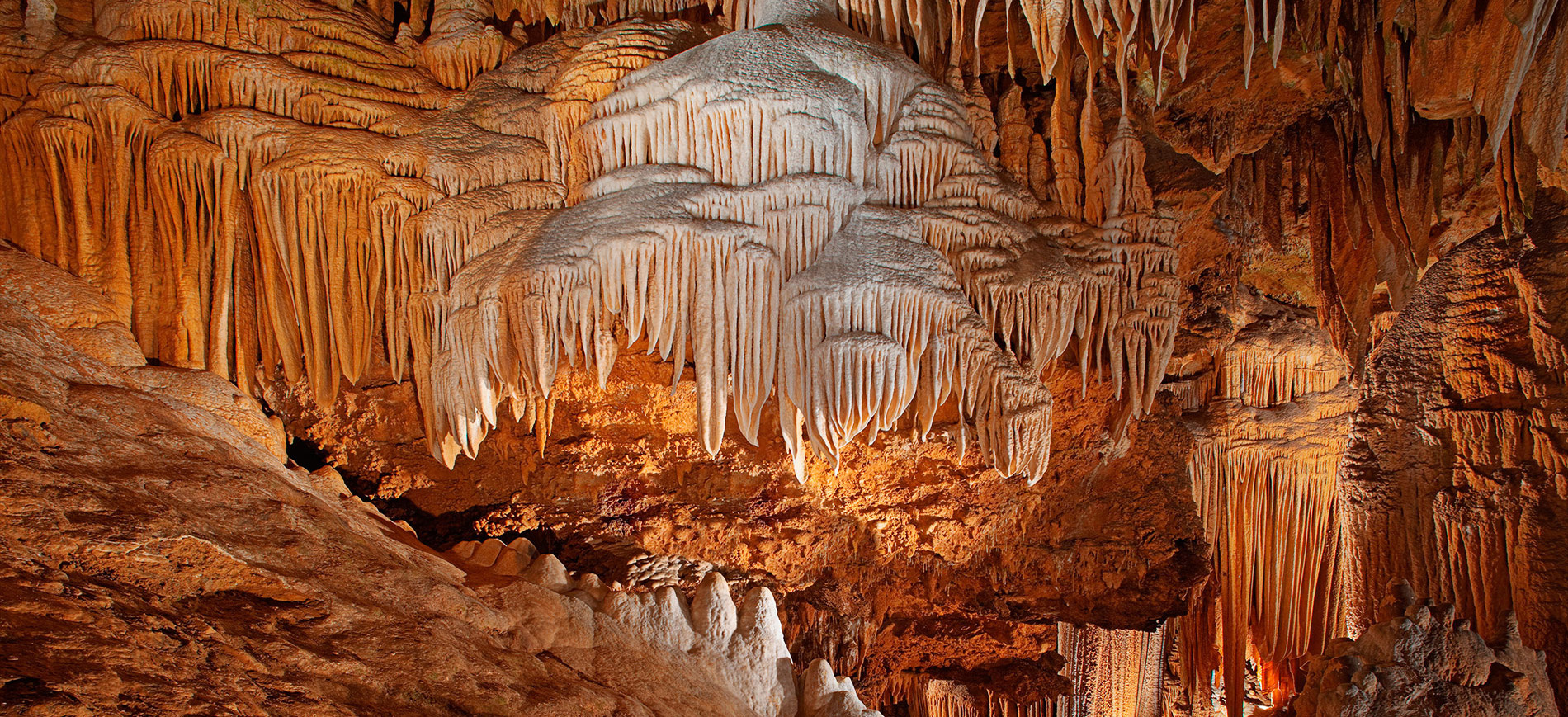
The first version of the body was a tool not capable of automatic operation. Everything changed after meeting Sprinkla with Larry Moyer. Moyer was an inventive teenager who developed an original automatic mechanical musical instrument for one of the school projects. At the same time, Larry worked in a cave as a guide. Learning about the talents of the young experimenter, Sprinkle joined forces with him. Thus, the stalactite organ received an automatic reproduction system.
Moyer shot:
No less speaking are the reviews of other cave employees about Leland Sprinkle. Luray Caverns marketing director, John Schaffer, who knew Leland in his childhood, said:
It should also be noted the contribution of Luray Caverns staff to work on the tool. Practically everyone who was connected with a private cave helped Leland as a personal initiative from below, which did not involve additional payment from the owners of the tourist object. Today, body systems are regularly maintained and updated.
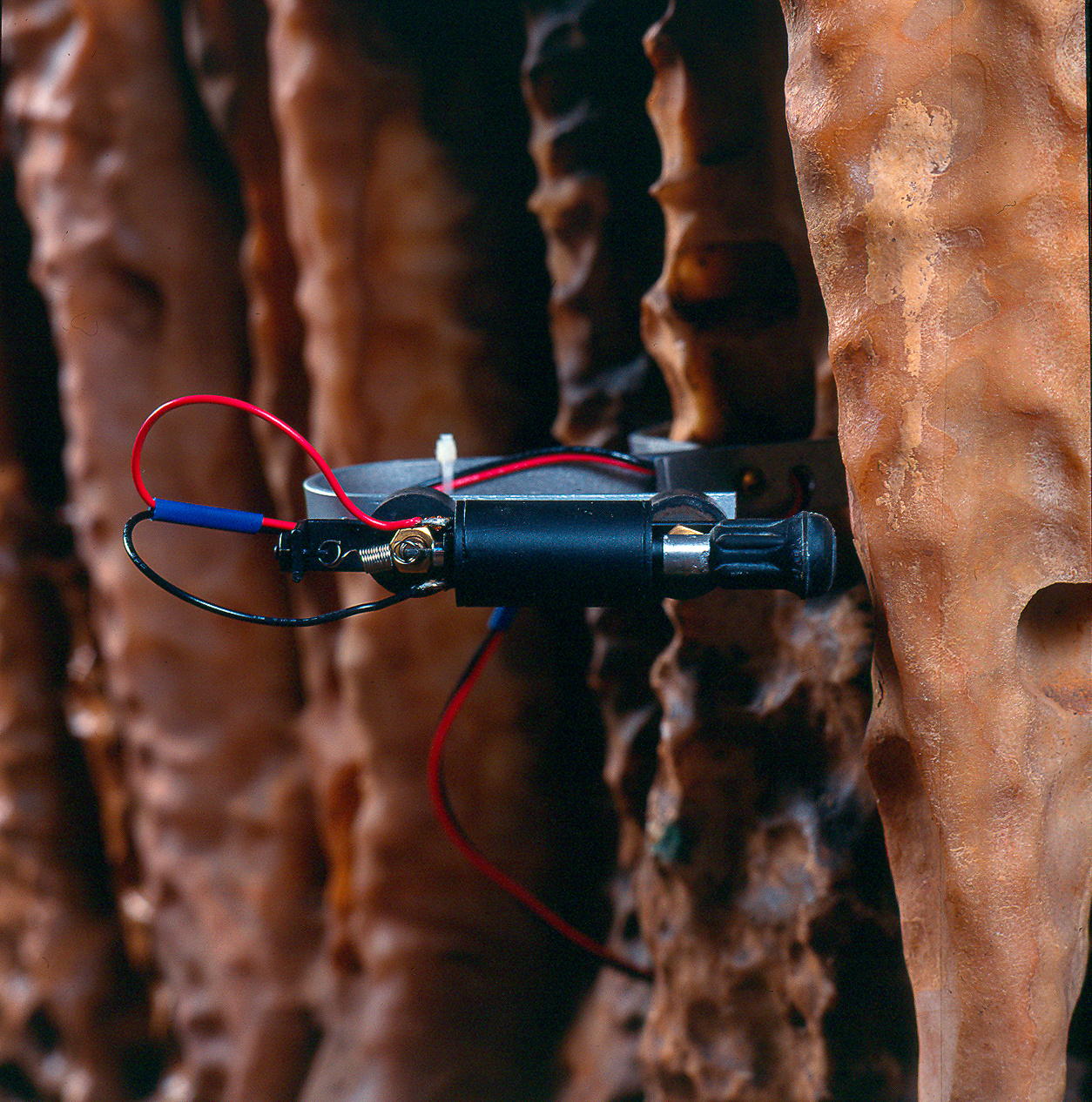
Further work on improving the tool lasted for 30 years. The main problem was to make the mechanical and electrical parts of the instrument as durable as possible and adapt to survival in the harsh conditions of the cave.
The instrument exists and operates to this day, attracting not only idle tourists, but also professional musicians. Since the mid-60s, several classical works performed by Leland himself and invited organists were recorded using the organ. There are original Lilad vinyl records (33 and 45 rpm), some of which are available at auction. Reprints can be bought when visiting Luray Caverns.
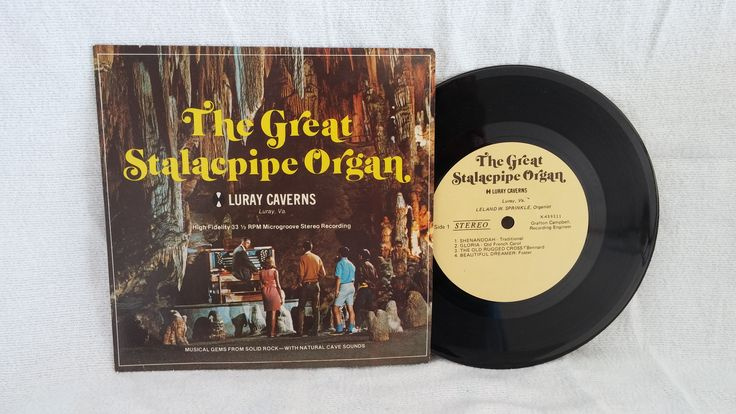
Organist Monte Maxwell was the first to record the samples of the instrument for the performance of classics and his own compositions on a synthesizer. His LP and CD have come out in limited editions, they can also be bought when visiting the cave.
The first work for the great stalactite organ, the composition “In The Cave”, was written and recorded in 2011 by the member of the Swedish-Finnish band Pepe Deluxé, Paul Malmström. The track was released on the album Queen of the Wave.
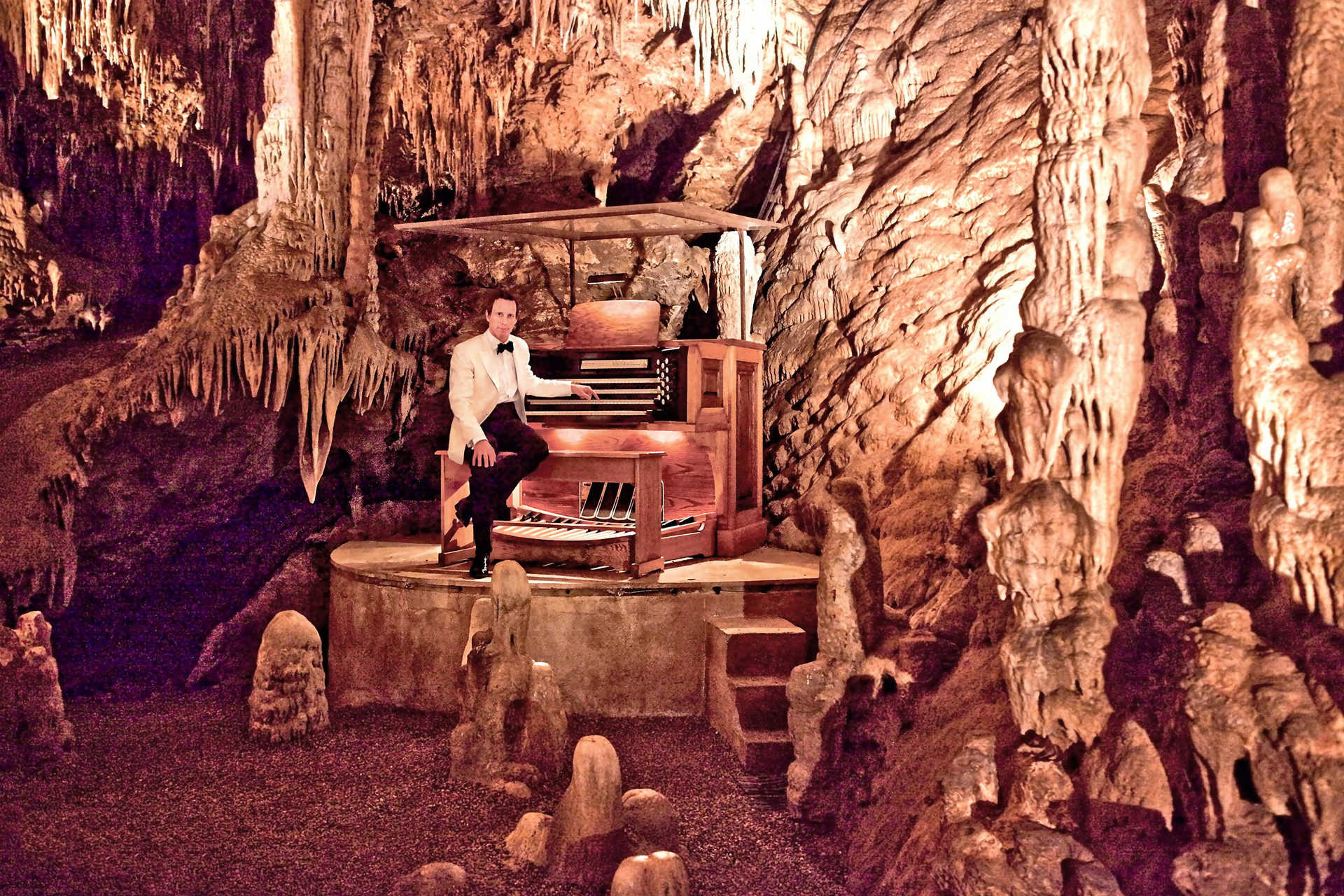
Paul Malstrom at Luray Caverns
To a question about the most attractive features of the organ, Malstrom answered:
The inventor of the largest instrument in the world, a scientist, engineer and organist Liland Strinkle died in 1990 and was buried in the cemetery of the city of Luray, a few kilometers from the caves.

In many ways, the history and personality of Sprinkla, as a military specialist and at the same time an enthusiast and inventor in the field of music, reminded me of our compatriot, the creator of the ANS synthesizer, Eugenia Murzin .
When creating a post, interviews and photographic materials published on:
www.onlyinyourstate.com
quibbll.com
www.odditycentral.com
interestinginstrument.com
www.clashmusic.com
www.odditycentral.com
www.treehugger.com
www.findagrave.com

To some extent, this material can be attributed to our other cycle “Personality and Sound”, since it will be devoted not only to the instrument, but also to its creator.
Music cave
Lureysky caves, located in Virginia (USA), were discovered by American speleologists in 1878. A group of scientists from Smithsonian University, led by Andrew Campbell, who studied the caves in the late 19th century, almost immediately drew attention to the interesting musical possibilities of rocky growths. The ability of stalactites to make interesting musical sounds on impact was noted in the Campbell report in 1880. According to the memoirs of the expedition participants, speleologists even managed to play several melodies.

At the beginning of the last century, the cave becomes a frequently visited sightseeing object. At this particular time, the regular excursion program includes the performance of popular melodies on the stalactites, the US anthem, marches of the times of the civil war and country music. By the mid-30s, cave excursions are losing popularity, which leads to the cessation of large-scale musical performances until 1957. The only thing that the guides did during this period was that they could play several short simple melodies.
Pentagon programmer, acoustics and amateur organist
Leland Wilfred Sprinkle was a versatile and interesting person. From his youth he was interested in the natural sciences, especially physics. Perhaps the world would recognize him not as the inventor of a unique musical instrument, but as one of the luminaries of physical science, but the tragic circumstances made adjustments to his fate.
In the late 1930s, as a young scientist, Leland began to prepare his doctoral dissertation in physics at Harvard, but could not complete and defend it. His father suddenly fell ill with appendicitis and, as a result of postoperative complications, died. Caring for his mother fell on Leland's shoulders and slowed down his scientific career.
Immediately after Harvard, he works in the US Treasury and the Federal Housing Administration. In the 1940s, Leland joined the US Department of Defense and began active work at the Pentagon as a computer programmer, mathematician, theorist, and electronics engineer. Many of his works were closely related to sea-based aviation and bomber aircraft, for example, pre-flight calculation algorithms. It is also known that he is one of the leading developers who worked on the creation of the UNIVAC computer.

UNIVAC
At the same time, the secret scientist was seriously interested in music, especially organ music, and from 1945 he studied to play this instrument at the Peabody Conservatory. The scientist did not leave a musical hobby and even received several patents for inventions in the musical field related to the rationalization of the organ systems that existed at that time.
I believe that the best description of Sprinkle as a scientist and inventor, was given in an interview by one of his sons - Dr. Robert Sprinkl:
“Wherever he is, he sought to make a contribution (to solving the problem). (What he proposed) usually reduced the number of equations needed to solve a multiparameter problem. ”
In addition, the son noted that the work of Leland was titanic and useful, but unobtrusive for his leadership, rarely received due recognition at the Pentagon. But this little worried scientist, who at times was more passionate about invention and music, rather than routine military developments.
In other words, Leland Sprinkle was a modest rationalizer by a perfectionist who earned money as a programmer, a mathematician and an engineer at the Pentagon, but remained a passionate innovator, amateur radio and musician.
Make the caves sing
The key moment in the creation of the “Great Organ” was the 5th birthday of Leland’s son, Robert, in 1954. To some extent, a five-year-old boy (in the future PhD) contributed to this matter. Leland offered his son a choice: celebrate his birthday at home or go on an excursion to the caves, and Robert chose the latter. During a visit to the cave, guides at a location called the Throne Room performed one of the folk tunes, tapping on stalactites like a xylophone. At that moment, the idea of a “Great organ” was born in the programmer

Modern day trip to Luray Caverns
Played the role and the fact that the cave Lurey and then and now are private property, which reduced the number of bureaucratic delays. Leland Sprinkles met with cave master Ted Graves. Sprinkle considered unlikely a situation in which Graves would agree to the creation of an organ, and was surprised that Ted did not even have to persuade. Instead of asking too many questions and a hard refusal, he responded to Leland's adventurous proposal with one phrase: “Of course, why not?”.
The principle that Leland implemented for the tool was simple. The keyboard of the organ was connected with an electromechanical shock mechanism. Depending on the key pressed, the hammer hit the stalactite, and he made a sound with a corresponding note.

In fact, it is an acoustic percussion instrument of unprecedented size. The reverberation and natural acoustic conditions of the cave created a unique sound, resembling something between a marimba, organ and metallophone.
Only two stalactites made a sound with a clean note, the rest had to be “tuned”. So Sprinkl filed stalactites to the desired size, comparing their sound with a tuning fork.

Leland Strinkle "adjusts" stalactite 1956
A big problem was the conditions in the cave, the temperature over 40C and the high level of humidity, which had a detrimental effect on the electrical circuits and mechanical parts of the organ.

Work on overcoming the problems, finding and preparing the necessary stalactites, placing the tool systems lasted 3 years. Due to the lack of experience in creating an organ keyboard, Sprinkle turned to Klann Organ Supply, which produced a unique console that still works today.
The console of the body is represented by four five-octave keyboards (different keyboards provide a different character of sound), allowing to extract only 36 whole tones and 25 semitones from the rock, just such a number of stalactites were able to produce the necessary sounds.

It is believed that in the next 5 hundred years no additional tincture will be needed. The stalactites used as sound sources are located on an area of 14,000 square meters. Due to the peculiarities of cave acoustics, the sound they emit is heard over an area of 260,000 square meters. To switch all the sounding stalactites needed cables with a total length of 5000 meters.

Automation and improvement of the musical giant
The first version of the body was a tool not capable of automatic operation. Everything changed after meeting Sprinkla with Larry Moyer. Moyer was an inventive teenager who developed an original automatic mechanical musical instrument for one of the school projects. At the same time, Larry worked in a cave as a guide. Learning about the talents of the young experimenter, Sprinkle joined forces with him. Thus, the stalactite organ received an automatic reproduction system.
Moyer shot:
“He was a very interesting person, a very good person. He loved to learn, and he loved to watch others learn. ”
No less speaking are the reviews of other cave employees about Leland Sprinkle. Luray Caverns marketing director, John Schaffer, who knew Leland in his childhood, said:
“He was a genius in matters of mathematics, science and music, he was also a teacher, and someone who could easily talk to anyone. He was always very kind to me, he always had time to show the child I was at the time, as something was working. ”
It should also be noted the contribution of Luray Caverns staff to work on the tool. Practically everyone who was connected with a private cave helped Leland as a personal initiative from below, which did not involve additional payment from the owners of the tourist object. Today, body systems are regularly maintained and updated.

Further work on improving the tool lasted for 30 years. The main problem was to make the mechanical and electrical parts of the instrument as durable as possible and adapt to survival in the harsh conditions of the cave.
The fate of the instrument and its creator
The instrument exists and operates to this day, attracting not only idle tourists, but also professional musicians. Since the mid-60s, several classical works performed by Leland himself and invited organists were recorded using the organ. There are original Lilad vinyl records (33 and 45 rpm), some of which are available at auction. Reprints can be bought when visiting Luray Caverns.

Organist Monte Maxwell was the first to record the samples of the instrument for the performance of classics and his own compositions on a synthesizer. His LP and CD have come out in limited editions, they can also be bought when visiting the cave.
The first work for the great stalactite organ, the composition “In The Cave”, was written and recorded in 2011 by the member of the Swedish-Finnish band Pepe Deluxé, Paul Malmström. The track was released on the album Queen of the Wave.

Paul Malstrom at Luray Caverns
To a question about the most attractive features of the organ, Malstrom answered:
“I have to say that this is the case when size matters. Even if he were not the largest instrument in the world, his concept would remain unique and amazing. You basically play uphill. It takes a great mind to come up with something like that. ”
The inventor of the largest instrument in the world, a scientist, engineer and organist Liland Strinkle died in 1990 and was buried in the cemetery of the city of Luray, a few kilometers from the caves.

In many ways, the history and personality of Sprinkla, as a military specialist and at the same time an enthusiast and inventor in the field of music, reminded me of our compatriot, the creator of the ANS synthesizer, Eugenia Murzin .
When creating a post, interviews and photographic materials published on:
www.onlyinyourstate.com
quibbll.com
www.odditycentral.com
interestinginstrument.com
www.clashmusic.com
www.odditycentral.com
www.treehugger.com
www.findagrave.com
All Articles